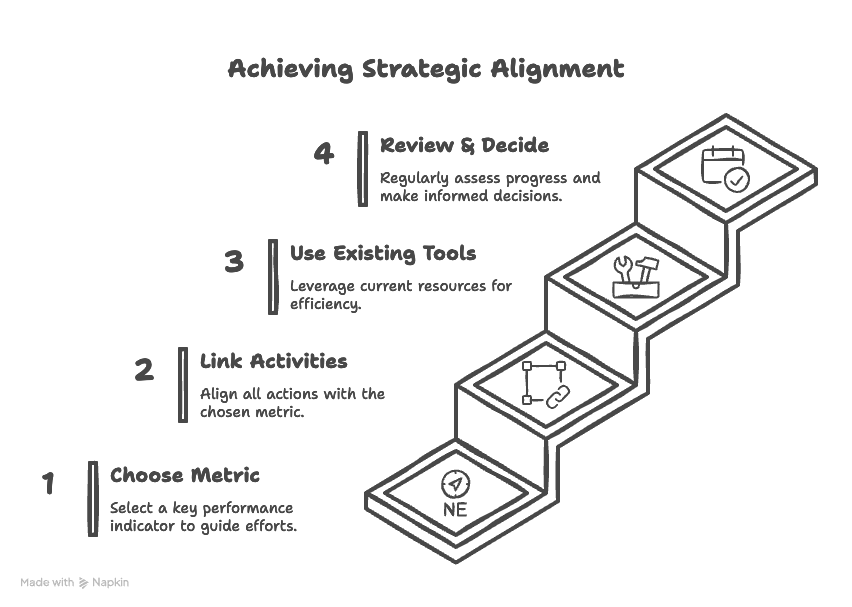How to Measure Marketing ROI Without a Full-Time CMO
Stop guessing what’s working. Here’s how growth-minded leaders can track marketing performance without hiring a full-time executive.
“We’re putting effort in, but I couldn’t tell you what’s actually moving the needle.”
If that sounds familiar, you’re not alone. Most early-growth companies are doing some form of marketing. Emails go out. Posts go up. Events get planned. But when someone asks, “Is it working?” The answer is usually a shrug, a gut feeling, or a scramble for last month’s web traffic.

It’s not that you’re doing it wrong. It’s that you’re flying blind without a system.
The Real Problem Isn’t Marketing. It’s Measurement.
Here’s what I see again and again: smart CEOs and operators spreading themselves thin. You’re overseeing product, hiring, revenue… and trying to piece together whether that webinar or newsletter actually did anything.
Marketing feels like a black box because no one has had the time, or the mandate, to structure it.
Just because someone on your team can design a Canva graphic or send a Mailchimp blast doesn’t mean you have marketing covered. Execution without a strategy is noise. And without measurement, it’s just noise you can’t even evaluate.
You don’t need more activity. You need a way to know what works.
How to Track ROI Without a Full-Time CMO
You don’t need a full marketing department to get clarity. You just need a process and a little discipline.
Here’s how to build it:

1. Choose One North Star Metric
Pick a primary outcome you care about right now. Not five. One.
Examples: Number of qualified leads, sales calls booked, demo requests, revenue from inbound.
This is your measuring stick. Everything else is secondary.
Without a clear target, marketing turns into busywork. With a target, it becomes focused effort.
2. Link Every Activity to That Outcome
Before your next campaign or content drop, ask: How will this move the needle on our primary metric?
Use UTM links in all your digital assets.
Log lead sources in your CRM or even a spreadsheet.
If attribution feels messy, keep it simple. “Where did this lead come from?” is a fine starting point.
Think of this as building your own mini dashboard, not for every KPI under the sun, but for the few that actually matter.
3. Use the Tools You Already Have
You don’t need an expensive platform. Chances are, you already have the basics.
Google Analytics: Set up goal conversions tied to your North Star metric.
CRM (HubSpot, Pipedrive, etc.): Log lead sources and automate reporting.
Spreadsheets: Seriously, Google Sheets + consistent input = powerful insight.
The key is consistency, not complexity.
4. Review Weekly. Decide Monthly.
Set a 30-minute slot each week to look at your numbers. Ask:
What’s trending up?
What’s flatlining?
What should we stop doing?
Then, once a month, use that data to make one change. Not ten. One.
This cadence gives you clarity without turning marketing into a second full-time job.
5. Common Pitfalls (and How to Avoid Them)
Tracking too much: You don’t need 15 KPIs. Focus on the one that maps to revenue.
Chasing vanity metrics: Likes ≠ leads. Email opens ≠ conversions.
Inaction: Data means nothing if you don’t use it to make decisions.
Most teams get stuck because they collect data without reviewing it, or review it without acting on it.
You Don’t Need to Be a Marketer. You Need a System.
At Wit Omni AI Marketing, I’ve helped operators and CEOs take the guesswork out of marketing…not by adding more to their plate, but by creating systems that run without constant oversight.
You don’t need to become a marketing expert. You need just enough clarity to make smart decisions and enough support to keep your focus where it belongs: leading the business.
Final Thought: You Can Get Smarter with Marketing
Even if you’re not ready to hire a full-time CMO, you can still build a marketing engine that’s measurable and aligned to growth.
If that sounds like a lot to wrangle on your own, that’s what I do every day. Let’s talk about what it could look like for your business. Schedule a free consultation HERE!
Or, keep going! This post is part of a series to help business leaders like you stop guessing and start leading.
